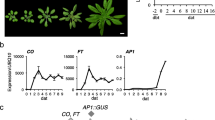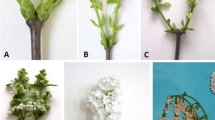Abstract
Unifoliated plants of Lolium temulentum L. Ceres were induced to flower by a unique 24-h long day (LD) consisting of the extension of the regular 8-h short day (SD) (400 μmol photons·m−2·s−1, fluorescence + incandescence) with incandescence at 10–15 μmol photonsm −2·s−1. The polyadenylated-RNA complement of leaf blade tissues was analysed at 4-h intervals during the photoperiod extension in LD vs. SD, by using two-dimensional polyacrylamide gel electrophoresis to resolve in-vitro-translated products. Of the 991 spots that were analysed, none appeared or disappeared during the inductive cycle, i.e. no qualitative effect of floral induction was detected, at any time. Sixty-eight spots were found whose intensity was influenced by lengthening of the photoperiod; 50 of them, i.e. ca. 5% of the population analysed, were affected before the end of the extension period and were thus potentially related to floral induction. Many of these RNAs were not quantitatively constant during a 24-h cycle in SD. Seven of them oscillated according to the ‘light-on’ and the ‘light-off’ signals, among which three seemed to be controlled by phytochrome since their relative amount increased under the standard light conditions but decreased under incandescence even faster than in darkness. The large majority of other RNAs varied with a timing that was not clearly driven by the alternation of light and darkness, indicating that genes related to the biological clock may be especially sensitive to the lengthening of the photoperiod. Furthermore, seven spots were observed that underwent a phase-shift in LD, which consisted, for six of them, of a phase advance of 4–8 h. The steady-state level of CAB mRNA was analysed because the CAB gene family (encoding the chlorophyll a/b-binding proteins of the light-harvesting complexes) is known to be controlled both by the biological clock and phytochrome. In SD, the level was high in the light and low in darkness; the fluctuation was conducted by a circadian rhythm. When plants were exposed to the inductive LD, the peak of mRNA accumulation that was expected according to the endogenous rhythmicity was abolished, possibly because of the change in light quality during the LD extension.
Similar content being viewed by others
Abbreviations
- CAB :
-
chlorophyll a/b-binding proteins of the light-harvesting complexes
- 2D:
-
two-dimensional
- LD(s):
-
longday(s)
- LDP(s):
-
long day plant(s)
- SD(s):
-
short day(s)
- SDP(s):
-
short day plant(s)
References
Anderson L (1988) Two-dimensional electrophoresis. Operation of the ISO-DALT system. Large Scale Biology Press, Washington
Ballard MJ, Jenkins GI (1991) A re-examination of reported changes in protein composition of leaves of Amaranthus caudatus during floral induction. Plant Cell Physiol 32: 1115–1117
Bassett CL, Mothershed CP, Galau GA (1991) Polypeptide profiles from cotyledons of developing and photoperiodically induced seedlings of the Japanese morning glory (Pharbitis [Ipomoea] nil). J Plant Growth Regul 10: 147–155
Bernier G (1976) La nature complexe du stimulus floral et des facteurs de floraison. In: Jacques R (ed) Etudes de biologie végétale: Hommage au Professeur P. Chouard. CNRS, Paris, pp 243–264
Bernier G, Havelange A, Houssa C, Petitjean A, Lejeune P (1993) Physiological signals that induce flowering. Plant Cell 5: 1147–1155
Chailakhyan MK (1937) Concerning the hormonal nature of plant development processes. Dokl Akad Nauk SSSR 16: 227–230
Cremer F, Dommes J, Van de Walle C, Bernier G (1990) Diurnal rhythmicity in the pattern of mRNAs in the leaves of Sinapis alba. Plant Physiol 94: 1590–1597
Cremer F, Van de Walle C, Bernier G (1991) Changes in mRNA level rhythmicity in the leaves of Sinapis alba during a lengthening of the photoperiod which induces flowering. Plant Mol Biol 17: 465–473
Evans LT (1958) Lolium temulentum L. a long-day plant requiring only one inductive photocycle. Nature 182: 197–198
Evans LT (1960) Inflorescence initiation in Lolium temulentum L. I. Effect of plant age and leaf area on sensitivity to photoperiodic induction. Aust J Biol Sci 13: 123–131
Evans LT (1976) Inflorescence initiation in Lolium temulentum L. XIV. The role of phytochrome in long-day induction. Aust J Plant Physiol 3: 207–217
Evans LT, Wardlaw IF (1964) Inflorescence initiation in Lolium temulentum L. IV. Translocation of the floral stimulus in relation to that of assimilates. Aust J Biol Sci 17: 1–9
Evans LT, Borthwick HA, Hendricks SB (1965) Inflorescence initiation in Lolium temulentum L. VII. Spectral dependence of induction. Aust J Biol Sci 18: 745–762
Greppin H, Bonzon M, Crespi P, Crèvecoeur M, Degli Agosti R, Penel C, Tacchini P (1991) Communication in plants. In: Penel C, Greppin H (eds) Plant signalling, plasma membrane, and change of state. Imprimerie Nationale, Genève, pp 139–177
Kannangara T, Durkin JP, ApSimon J, Wightman F (1990) Changes in the polypeptide profiles during photoinduction of Xanthium strumarium. Physiol Plant 78: 519–525
Kawakami N, Watanabe A (1988) Effects of light illumination on the population of translatable mRNA in radish cotyledons during dark-induced senescence. Plant Cell Physiol 29: 347–353
Lang A (1980) Inhibition of flowering in long-day plants. In: Skoog F (ed) Plant growth substances. Springer-Verlag, Berlin, pp 310–322
Laskey RA, Mills AD (1975) Quantitative film detection of 3H and 14C in polyacrylamide gels by fluorography. Eur J Biochem 56: 335–341
Lay-Yee M, Sachs RM, Reid MS (1987) Changes in cotyledon mRNA during floral induction of Pharbitis nil cv. Violet. Planta 171: 104–109
Lechner FJ, Rau W (1993) A complex pattern of changes in polysomal messenger RNA populations is evident in the leaves of Arabidopsis thaliana (L.) Heynh.during photoperiodic induction of flowering. Planta 189: 522–532
Lee I, Aukerman MJ, Gore SL, Lohman KN, Michaels SD, Weaver LM, John MC, Feldmann KA, Amasino RM (1994) Isolation of LUMINIDEPENDENS: a gene involved in the control of flowering time in Arabidopsis. Plant Cell 6: 75–83
Lefort F, Thiellement H, Greppin H (1991) Polypeptide pattern modifications during floral induction in leaves of Spinada oleracea. Arch Sci Genève 44: 227–234
Malik NSA (1987) Senescence in oat leaves: changes in translatable mRNAs. Physiol Plant 70: 438–446
Meyer H, Thienel U, Piechulla B (1989) Molecular characterisation of the diurnal/circadian expression of the chlorophyll a/b-binding proteins in leaves of tomato and other dicotyledonous and monocotyledonous plant species. Planta 180: 5–15
Nagy F, Kay SA, Chua N-H (1988) Gene regulation by phytochrome. Trends Genet 4: 37–42
O'Farrell PH (1975) High resolution two-dimensional electrophoresis of proteins. J Biol Chem 250: 4007–4021
O'Neill SD (1993) Changes in gene expression associated with floral induction and evocation. In: Jordan BR (ed) The molecular biology of flowering. CAB International, Wallingford, pp 69–92
O'Neill SD, Zhang XS, Zheng CC (1994) Dark and circadian regulation of mRNA accumulation in the short-day plant Pharbitis nil. Plant Physiol 104: 569–580
Ono M, Yamada K, Sage K, Okazaki M, Harada H (1991) Changes in in-vitro-translated polypeptides of Pharbitis nil Chois. strain Violet cotyledons during the first flower-inductive and noninductive photoperiods. Plant Sci 78: 11–18
Ono M, Ono KS, Yasui M, Okasaki M, Harada H (1993) Changes in polypeptides in Pharbitis cotyledons during the first flowerinductive photoperiod. Plant Sci 89: 135–145
Ougham HJ, Thomas H, Hilditch P (1987) Leaf development in Lolium temulentum L.: Gradients of expression of growth and photosynthesis-related polypeptides revealed by immunoblotting. J Plant Physiol 129: 181–186
Périlleux C, Bernier G, Kinet J-M (1994) Circadian rhythms and the induction of flowering in the long-day grass Lolium temulentum. Plant Cell Environ 17: 755–761
Piechulla B (1989) Changes of the diurnal and circadian (endogenous) mRNA oscillations of the chlorophyll a/b binding protein in tomato leaves during altered day/night (light/dark) regimes. Plant Mol Biol 12: 317–327
Piechulla B (1993) ‘Circadian clock’ directs the expression of plant genes. Plant Mol Biol 22: 533–542
Putterill J, Robson F, Lee K, Simon R, Coupland G (1995) The CONSTANS gene of Arabidopsis promotes flowering and encodes a protein showing similarities to zinc finger transcription factors. Cell 80: 847–857
Riesselmann S, Piechulla B (1990) Effect of dark phases and temperature on the chlorophyll a/b binding protein mRNA level oscillations in tomato seedlings. Plant Mol Biol 14: 605–616
Sambrook J, Fritsch EF, Maniatis T (1989) Molecular cloning. A laboratory manual. Cold Spring Harbor Laboratory Press, Cold Spring Harbor
Sawhney S, Sawhney N, Nanda KK (1976) Gel electrophoretic studies of proteins in photo-induced and vegetative plants of Impatiens balsamina. Plant Cell Physiol 17: 751–755
Simpson J, Herrera-Estrella L (1990) Light-regulated gene expression. Crit Rev Plant Sci 9: 95–109
Stiles JI Jr, Davies PJ (1976) Qualitative analysis by isoelectric focusing of the protein content of Pharbitis nil apices and cotyledons during floral induction. Plant Cell Physiol 17: 855–857
Tanaka O, Takeba G, Izawa K, Mera T (1990) Inhibition of flower induction by some inhibitors of protease in the short-day plant Lemna paucicostata 6746 and the long-day plant Lemna gibba G3. Plant Cell Physiol 31: 383–389
Warm E (1984) Changes in the composition of in-vitro-translated leaf mRNA caused by photoperiodic flower induction of Hyoscyamus niger. Physiol Plant 61: 344–350
Woolhouse HW (1983) Hormonal control of senescence allied to reproduction in plants. In: Meudt WJ (ed) Strategies of plant reproduction. Allanheld, Osmun, New Jersey, pp 201–233
Author information
Authors and Affiliations
Corresponding author
Additional information
This work was supported by the University of Liège through the ‘Action de Recherche Concertée’ (# 88/93-129). Some analyses were performed with the collaboration of Dr. H. Ougham, Institute of Grassland and Environmental Research, Aberystwyth, UK. The authors also want to thank Dr. F. Cremer (Max Planck Institute for Plant Breeding, Köln, Germany) for critical discussion of the results.
Rights and permissions
About this article
Cite this article
Périlleux, C., Ongena, P. & Bernier, G. Changes in gene expression in the leaf of Lolium temulentum L. Ceres during the photoperiodic induction of flowering. Planta 200, 32–40 (1996). https://doi.org/10.1007/BF00196646
Received:
Accepted:
Issue Date:
DOI: https://doi.org/10.1007/BF00196646




